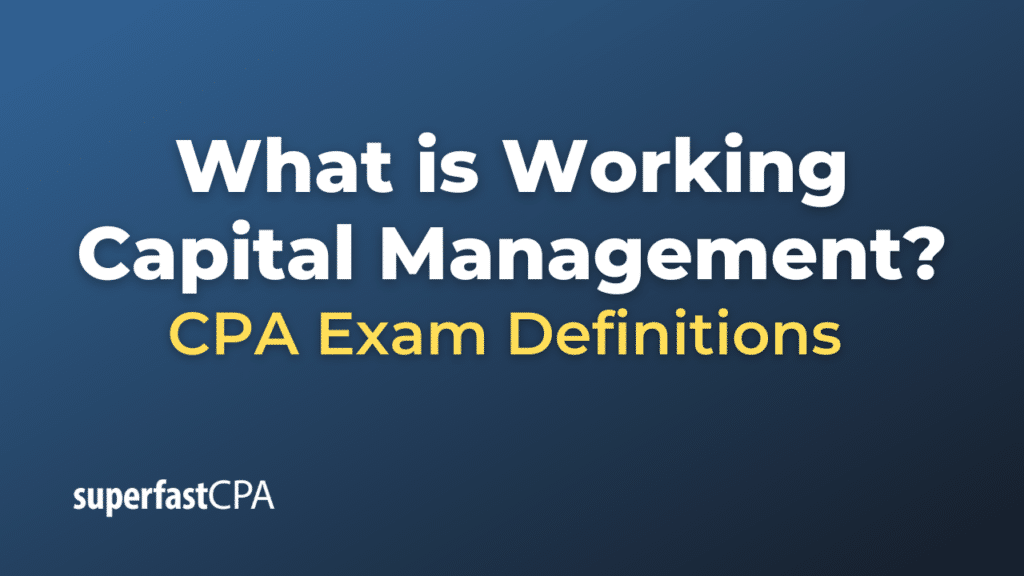Working Capital Management
Working capital management involves the administration of a company’s current assets (such as cash, accounts receivable, and inventory) and current liabilities (like accounts payable, short-term loans, and other short-term debts) to ensure that the firm has sufficient liquidity to meet its short-term obligations and operational expenses. Effective working capital management is essential for maintaining the financial health and operational stability of a business.
Key Objectives:
- Ensuring Liquidity: One of the primary goals is to ensure that the company can meet its short-term liabilities as they come due.
- Optimizing the Asset Utilization: Efficiently managing inventories, accounts receivable, and cash to ensure smooth business operations without tying up too much capital unnecessarily.
- Cost Minimization: Through proper negotiation with suppliers and creditors to extend credit terms, as well as taking advantage of discounts, a business aims to minimize costs associated with its working capital needs.
Key Components:
- Accounts Receivable Management: This involves establishing policies for extending credit to customers, collecting payments, and minimizing the risk of bad debts.
- Inventory Management: This includes determining optimal stock levels for raw materials, work-in-progress, and finished goods to meet demand without incurring holding or stockout costs.
- Cash Management: Includes deciding the amount of cash that should be kept on hand and how surplus cash should be invested.
- Accounts Payable Management: This involves negotiating favorable terms with suppliers and ensuring that payments are made in a way that maximizes the firm’s financial flexibility.
Key Ratios for Analysis:
- Current Ratio: \(\text{Current Ratio} = \frac{\text{Current Assets}}{\text{Current Liabilities}} \)
- Quick Ratio: \(\text{Quick Ratio} = \frac{\text{Current Assets – Inventory}}{\text{Current Liabilities}} \)
- Working Capital Turnover: \(\text{Working Capital Turnover} = \frac{\text{Revenue}}{\text{Average Working Capital}} \)
- Days Sales Outstanding (DSO): \(\text{DSO} = \frac{\text{Accounts Receivable}}{\text{Daily Sales}} \)
- Inventory Turnover: \(\text{Inventory Turnover} = \frac{\text{Cost of Goods Sold}}{\text{Average Inventory}} \)
Benefits of Effective Working Capital Management:
- Improved Profitability: Optimal utilization of resources can lead to increased operational efficiency, reducing costs and improving margins.
- Enhanced Liquidity: A focus on liquidity ensures that the company can meet its short-term obligations, thereby reducing financial risk.
- Better Relationships: Timely payments to suppliers and employees can lead to improved relations and potentially better terms.
- Strategic Focus: Efficient working capital management frees up resources for strategic investments and growth.
Poor working capital management can result in operational difficulties, financial insolvency, and even bankruptcy. Hence, it is crucial for business leaders to give due attention to this aspect of financial management.
Example of Working Capital Management
Let’s consider a fictional example of a small manufacturing company called “CraftyWidgets Inc.” to illustrate the principles of working capital management.
Financial Information for CraftyWidgets Inc.
Current Assets:
- Cash: $20,000
- Accounts Receivable: $50,000
- Inventory: $30,000
- Total Current Assets: $100,000
Current Liabilities:
- Accounts Payable: $25,000
- Short-term Loans: $15,000
- Total Current Liabilities: $40,000
Revenue for the year: $400,000
Cost of Goods Sold (COGS): $250,000
Working Capital Management Strategies:
- Accounts Receivable: CraftyWidgets has been allowing a credit period of 60 days to its customers. To improve cash flow, they decide to offer early payment discounts, successfully reducing the average credit period to 45 days. This accelerates cash inflow.
- Inventory Management: They discover they have a slow turnover rate for a particular type of widget. The company decides to implement a just-in-time inventory system, reducing the average amount of inventory held and thereby cutting holding costs.
- Cash Management: With $20,000 cash on hand, CraftyWidgets decides to keep $10,000 for unexpected expenses and invests $10,000 in a short-term marketable security that can be easily liquidated.
- Accounts Payable: CraftyWidgets negotiates terms with suppliers to extend the payment period from 30 to 45 days without incurring penalties.
Key Ratios After Strategies Implemented:
- Current Ratio:
- \(\frac{100,000}{40,000} = 2.5 \)
- Quick Ratio:
- \(\frac{100,000 – 30,000}{40,000} = 1.75 \)
- Working Capital Turnover:
- \(\frac{400,000}{60,000} = 6.67 \) (New working capital is $100,000 – $40,000 = $60,000)
- Days Sales Outstanding (DSO):
Reduced from 60 days to 45 days due to the new credit policy. - Inventory Turnover:
Improved due to the just-in-time inventory system, leading to lower holding costs.
Analysis:
- Liquidity: CraftyWidgets has a healthy current ratio and quick ratio, indicating it has sufficient assets to cover its liabilities.
- Efficiency: The working capital turnover ratio suggests an efficient use of working capital, especially after the changes in accounts receivable and inventory management.
- Cost Savings: By reducing holding costs and accelerating accounts receivable, the company improves its profitability.
- Financial Flexibility: With better cash management and extended payable terms, CraftyWidgets gains more financial flexibility, enabling it to take advantage of new opportunities or deal with unexpected challenges.
Through effective working capital management, CraftyWidgets Inc. has not only secured its short-term financial stability but has also created an environment for sustainable long-term growth.














